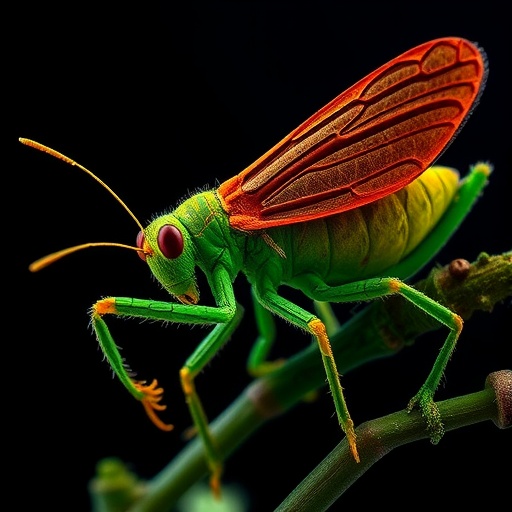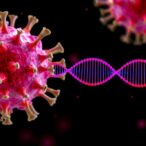
In a groundbreaking study poised to reshape our understanding of insect chemical communication, researchers have meticulously decoded the biosynthesis pathway of 4-vinylanisole (4VA), a critical aggregation pheromone in locusts. This discovery deepens the insight into how locusts orchestrate mass swarming behavior through precise enzymatic processes. The team not only identified the integral enzymes involved in the biosynthesis of 4VA but also developed potent small-molecule inhibitors capable of disrupting this pathway, presenting novel strategies for pest control.
Central to this investigation are the enzymes known as 4-vinylphenol methyltransferases (4VPMTs), which facilitate the enzymatic methylation of 4-vinylphenol (4VP) into 4VA. The researchers systematically interrogated the substrate specificity of these enzymes by employing various 4VP analogues. Notably, compounds lacking the phenol hydroxyl group, such as styrene derivatives with para-substitutions including amino, nitro, and iodo groups, were surprisingly ineffective at inhibiting 4VPMT activity, even at high molar excess. This finding underscores the essential role of the phenol hydroxyl group in substrate recognition and binding to 4VPMTs.
Moving beyond preliminary inhibitor screens, the study brilliantly pivoted to explore a panel of para-substituted phenols carrying diverse functional groups. This screening revealed 4-nitrophenol (4NP) and 4-trifluoromethylphenol as exceptionally potent inhibitors, each resulting in over 300-fold reductions in 4VPMT1 enzymatic activity. Subsequent in-depth biochemical assays quantified the inhibitory strength, with 4NP exhibiting half-maximal inhibitory concentration (IC50) values in the low nanomolar range against both 4VPMT1 and 4VPMT2 isoforms. Such low IC50 values indicate a remarkable affinity and efficacy, highlighting these molecules as promising leads for disrupting pheromone biosynthesis.
.adsslot_EOvcgDjCPh{width:728px !important;height:90px !important;}
@media(max-width:1199px){ .adsslot_EOvcgDjCPh{width:468px !important;height:60px !important;}
}
@media(max-width:767px){ .adsslot_EOvcgDjCPh{width:320px !important;height:50px !important;}
}
ADVERTISEMENT
Delving into enzyme kinetics provided further clarity on the inhibitory mechanisms. Kinetic parameters demonstrated that 4NP binds to 4VPMTs with high affinity, evidenced by notably low Michaelis constants (Km), especially for 4VPMT1. Remarkably, although 4NP could be methylated into 4-nitroanisole (4NA), the conversion rates starkly contrasted with those of the natural substrate 4VP, revealing that catalytic efficiency for 4NP is significantly compromised. Structural modeling illuminated the binding dynamics, revealing specific hydrogen bonding interactions—such as the interaction between tryptophan residue W174 and 4NP in 4VPMT1—that underpin the inhibitor’s potent binding but limited catalytic turnover.
In vivo experiments elegantly validated these biochemical insights. Injection of 4NP into locusts led to robust suppression of 4VA production at doses spanning two orders of magnitude, confirming that enzymatic inhibition translates into physiological impact. This inhibition was temporally transient, with measurable effects persisting up to four hours before dissipating, suggesting metabolic or clearance pathways modulate inhibitor longevity. Furthermore, feeding locusts with wheat seedlings treated with 4NP similarly attenuated 4VA production, indicating environmental applicability.
The behavioral ramifications of 4NP-mediated inhibition of 4VA synthesis were equally profound. Locusts exposed to volatiles emitted from 4NP-treated groups exhibited marked aversion, preferring odors from untreated controls, which revealed a disruption in chemical communication cues critical for aggregation. Detailed behavioral assays showed significant shifts from gregarious to solitary phenotypes in locusts after 4NP treatment, highlighting the direct influence of pheromone dynamics on swarm formation. Strikingly, solitary locusts subjected to crowding combined with 4NP feeding displayed inhibited transition toward gregarious behavior, underscoring the inhibitor’s potential as a behavioral modulator.
To rule out off-target or confounding effects, further analyses were conducted. Locusts showed no intrinsic attraction or repulsion responses directly to 4NP itself, indicating that the compound’s effects are mediated through inhibition of pheromone production rather than sensory deception. Volatile organic compound profiling revealed slight reductions in emissions of compounds like m-xylene and nonane; however, these did not evoke significant behavioral changes in choice or preference assays. Electrophysiological evaluations confirmed stable olfactory receptor neuron responses for 4VA in 4NP-fed locusts versus controls, supporting the notion that sensory perception remained intact while pheromone synthesis was disrupted.
Given the limitations and potential safety concerns of applying 4NP in ecological settings, the researchers expanded their scope through computational virtual screening of a preclinical and clinical drug library. This innovative approach yielded tolcapone, a catechol-O-methyltransferase inhibitor used in Parkinson’s disease treatment, as a promising candidate exhibiting approximately 85% inhibition of 4VPMT1 enzymatic activity in vitro. Remarkably, tolcapone administration via injection and feeding effectively suppressed 4VA production in both gregarious and crowded solitary locust populations, offering a potentially safer and pharmacologically characterized insect management tool.
This pioneering research not only elucidates the fine molecular choreography governing locust aggregation pheromone biosynthesis but also presents novel avenues to disrupt this process in a targeted manner. By strategically inhibiting 4VPMTs, the production of 4VA can be curtailed, resulting in behavioral shifts away from swarming—a development with profound implications for controlling devastating locust plagues threatening global agriculture. The convergence of biochemical enzymology, behavioral ecology, and drug repurposing exemplifies a multidisciplinary breakthrough with substantial real-world applications.
Future work building upon these findings could refine inhibitor selectivity and stability, while field trials will be essential to assess ecological safety and efficacy under commercial agricultural conditions. Moreover, the mechanistic insights into enzyme-substrate-inhibitor interactions pave the way for rational design of next-generation molecules with optimized characteristics. This study thus marks a milestone in pest management science, merging molecular biology with pragmatic solutions for one of humanity’s oldest and most destructive agricultural challenges.
In sum, the deciphering of 4VA biosynthesis and the identification of robust enzymatic inhibitors herald a new frontier in the biological control of locust swarms. By disabling the chemical signals that drive mass aggregation, we can envisage novel, environmentally sound strategies to mitigate one of nature’s most dramatic and economically damaging insect phenomena.
Subject of Research: Deciphering the biosynthetic pathway of the locust aggregation pheromone 4-vinylanisole (4VA) and characterization of its key methyltransferase enzymes, alongside the development of effective enzymatic inhibitors.
Article Title: Decoding 4-vinylanisole biosynthesis and pivotal enzymes in locusts
Article References:
Guo, X., Gao, L., Li, S. et al. Decoding 4-vinylanisole biosynthesis and pivotal enzymes in locusts. Nature (2025). https://doi.org/10.1038/s41586-025-09110-y
Image Credits: AI Generated
Tags: 4-vinylanisole biosynthesis in locusts4-vinylphenol methyltransferasesaggregation pheromones in insectsbiochemical pathways in locustsenzymatic processes in swarming behaviorinsect pheromone biosynthesislocust chemical communicationpara-substituted phenols as inhibitorspest management strategiesphenol hydroxyl group importancesmall-molecule inhibitors for pest controlsubstrate specificity of methyltransferases



